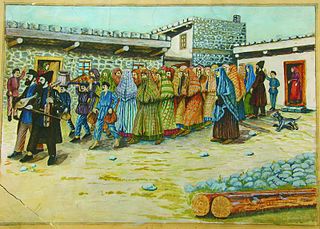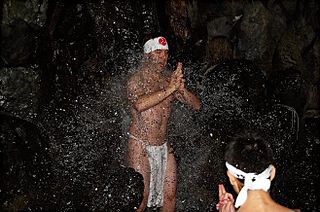 W
WRitual purification is the ritual prescribed by a religion by which a person is considered to be free of uncleanliness, especially prior to the worship of a deity, and ritual purity is a state of ritual cleanliness. Ritual purification may also apply to objects and places. Ritual uncleanliness is not identical with ordinary physical impurity, such as dirt stains; nevertheless, body fluids are generally considered ritually unclean.
 W
WIn Christianity, ablution is a prescribed washing of part or all of the body or possessions, such as clothing or ceremonial objects, with the intent of purification or dedication. In Christianity, both baptism and footwashing are forms of ablution. Prior to praying the canonical hours at seven fixed prayer times, Oriental Orthodox Christians wash their hands and face. In liturgical churches, ablution can refer to purifying fingers or vessels related to the Eucharist. In the New Testament, washing also occurs in reference to rites of Judaism part of the action of a healing by Jesus, the preparation of a body for burial, the washing of nets by fishermen, a person's personal washing of the face to appear in public, the cleansing of an injured person's wounds, Pontius Pilate's washing of his hands as a symbolic claim of innocence and foot washing, now partly a symbolic rite within the Church. According to the Gospel of Matthew, Pontius Pilate declared himself innocent of the blood of Jesus by washing his hands. This act of Pilate may not, however, have been borrowed from the custom of the Jews. The same practice was common among the Greeks and Romans.
 W
WBucket and Cone refer to twin attributes that are frequently held in the hands of winged genies depicted in the art of Mesopotamia and within the context of Ancient Mesopotamian religion, particularly in art from the Neo-Assyrian Empire and especially Assyrian palace reliefs from this period - sometimes, however, only the bucket is held, and the other hand is held up in what may be a blessing gesture. To a lesser degree such images were also depicted in images from the Neo-Sumerian Empire, Old Assyrian Empire, Babylonian Empire and Middle Assyrian Empire.
 W
WChilla is a spiritual practice of penance and solitude in Sufism known mostly in Indian and Persian traditions. In this ritual a mendicant or ascetic attempts to remain seated in a circle practicing meditation techniques without food for 40 days and nights in imitation of the Arba'een. The word chilla is derived from the Persian word chehel "forty". Chilla is commonly performed in a solitary cell called a chilla-khana.
 W
WA chōzubachi (手水鉢), or water bowl, is a vessel used to rinse the hands in Japanese temples, shrines and gardens. Usually made of stone, it plays an important role in the tea ceremony. Guests use it to wash their hands before entering the tea room, a practice originally adapted from the custom of rinsing one’s mouth and cleansing one’s body in the chōzuya before entering the sacred precincts of a Shinto shrine or a Buddhist temple.
 W
WChōzu-ya or temizu-ya is a Shinto water ablution pavilion for a ceremonial purification rite known as temizu or chōzu . The pavillion contains a large water-filled basin called a chōzubachi .
 W
WHarae or harai is the general term for rituals of purification in Shinto. Harae is one of four essential elements involved in a Shinto ceremony. The purpose is the purification of pollution or sins (tsumi) and uncleanness (kegare). These concepts include bad luck and disease as well as guilt in the English sense.
 W
WImpurity after childbirth is the religious or cultural belief that a new mother is in a state of uncleanliness or pollution, requiring ritual purification. It is connected to the seclusion imposed by the expectations of postpartum confinement, and more broadly to the taboos around menstruation and bleeding.
 W
WLustratio was an ancient Greek and ancient Roman purification ritual. It included a procession and in some circumstances the sacrifice of a pig (sus), a ram (ovis), and a bull (taurus) (suovetaurilia).
 W
WMikveh or mikvah is a bath used for the purpose of ritual immersion in Judaism to achieve ritual purity.
 W
WMisogi (禊) is a Japanese Shinto practice of ritual purification by washing the entire body. Misogi is related to another Shinto purification ritual called Harae – thus both being collectively referred to as misogiharae (禊祓).
 W
WA sweat lodge is a low profile hut, typically dome-shaped or oblong, and made with natural materials. The structure is the lodge, and the ceremony performed within the structure may be called by some cultures a purification ceremony or simply a sweat. Traditionally the structure is simple, constructed of saplings covered with blankets and sometimes animal skins. Originally, it was only used by some of the Indigenous peoples of the Americas, notably the Plains Indians, but with the rise of pan-Indianism, numerous nations that did not originally have the sweat lodge ceremony have adopted it. This has been controversial.
 W
WA temazcal is a type of low heat sweat lodge, which originated with pre-Hispanic Indigenous peoples in Mesoamerica. The term temazcal comes from the Nahuatl word temāzcalli [temaːsˈkalːi], or possibly from the Nahuatl words teme and calli (house).
 W
WIn Japan, a tsukubai (蹲踞) is a washbasin provided at the entrance to a holy place for visitors to purify themselves by the ritual washing of hands and rinsing of the mouth. This type of ritual cleansing is the custom for guests attending a tea ceremony or visiting the grounds of a Buddhist temple. The name originates from the verb tsukubau meaning "to crouch" or "to bow down", an act of humility. Guests attending a tea ceremony crouch and wash their hands in a tsukubai set in the tea garden (roji) before entering the tearoom.
 W
WWashing and anointing is a temple ordinance practiced by The Church of Jesus Christ of Latter-day Saints and Mormon fundamentalists as part of the faith's endowment ceremony. It is a sacred ordinance for adults, similar to chrismation, usually performed at least a year after baptism. The ordinance is performed by the authority of the Melchizedek priesthood by an officiator of the same gender as the participant.